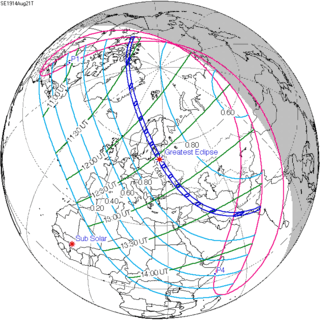Solar eclipse of August 21, 1914
| Solar eclipse of August 21, 1914 | |
|---|---|
 Map | |
| Type of eclipse | |
| Nature | Total |
| Gamma | 0.7655 |
| Magnitude | 1.0328 |
| Maximum eclipse | |
| Duration | 134 sec (2 m 14 s) |
| Coordinates | 54°30′N 27°06′E / 54.5°N 27.1°E |
| Max. width of band | 170 km (110 mi) |
| Times (UTC) | |
| Greatest eclipse | 12:34:27 |
| References | |
| Saros | 124 (49 of 73) |
| Catalog # (SE5000) | 9314 |
A total solar eclipse occurred on August 21, 1914. A solar eclipse occurs when the Moon passes between Earth and the Sun, thereby totally or partly obscuring the image of the Sun for a viewer on Earth. A total solar eclipse occurs when the Moon's apparent diameter is larger than the Sun's, blocking all direct sunlight, turning day into darkness. Totality occurs in a narrow path across Earth's surface, with the partial solar eclipse visible over a surrounding region thousands of kilometres wide. The totality of this eclipse was visible from northern Europe and Asia. It was the first of four total solar eclipses that would be seen from Sweden during the next 40 years.
Related eclipses
Solar eclipses of 1913-1917
Each member in a semester series of solar eclipses repeats approximately every 177 days and 4 hours (a semester) at alternating nodes of the Moon's orbit.
| Descending node | Ascending node | |||
|---|---|---|---|---|
| 114 | August 31, 1913 Partial |
119 | February 25, 1914 Annular | |
| 124 | August 21, 1914 Total |
129 | February 14, 1915 Annular | |
| 134 | August 10, 1915 Annular |
139 | February 3, 1916 Total | |
| 144 | July 30, 1916 Annular |
149 | January 23, 1917 Partial | |
| 154 | July 19, 1917 Partial | |||
References
- Earth visibility chart and eclipse statistics Eclipse Predictions by Fred Espenak, NASA/GSFC
| Wikimedia Commons has media related to Solar eclipse of 1914 August 21. |
